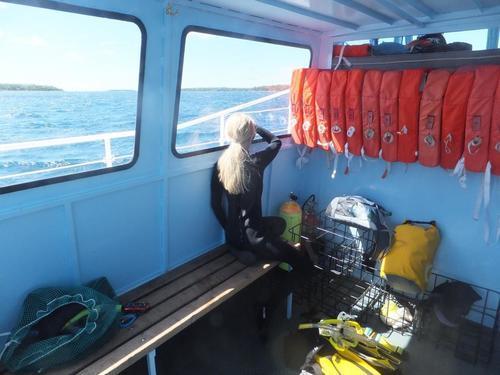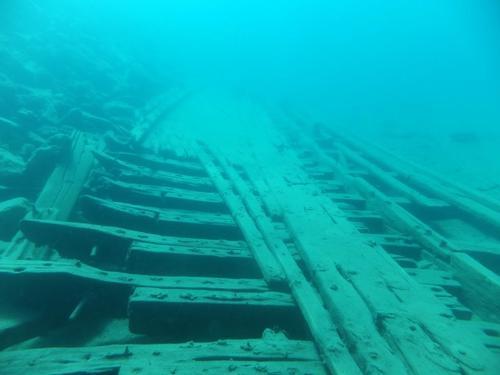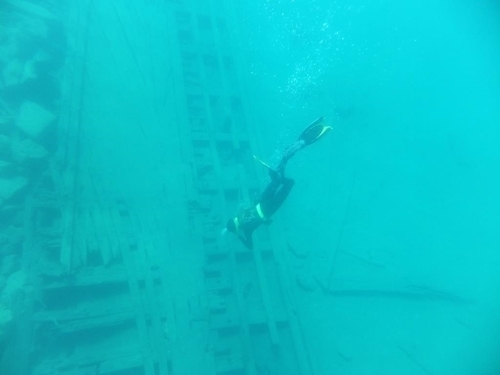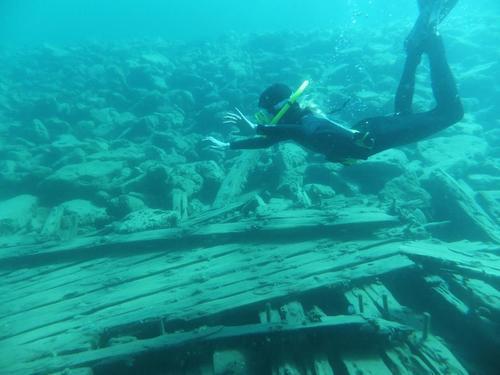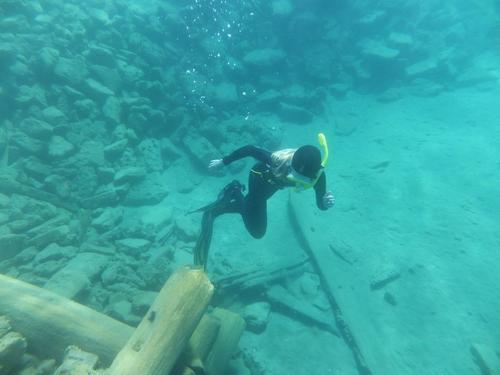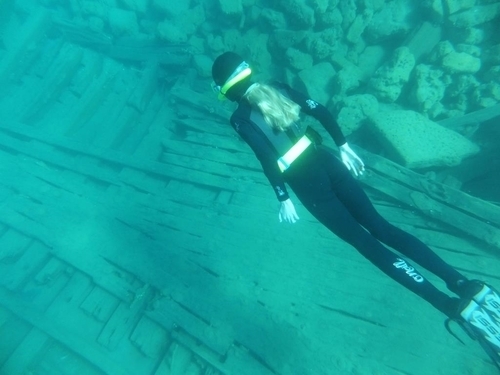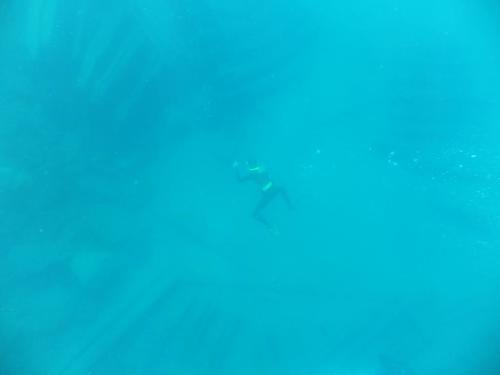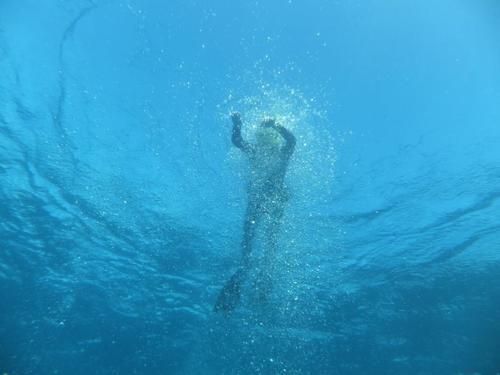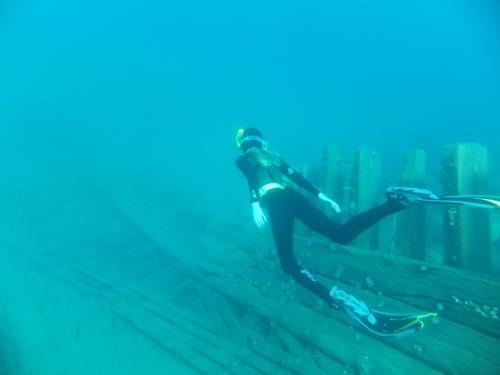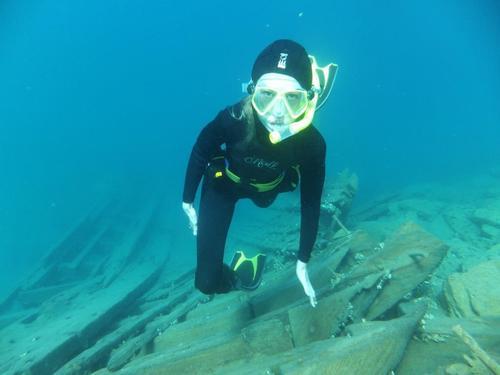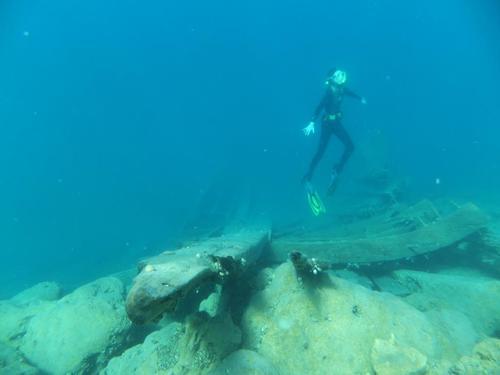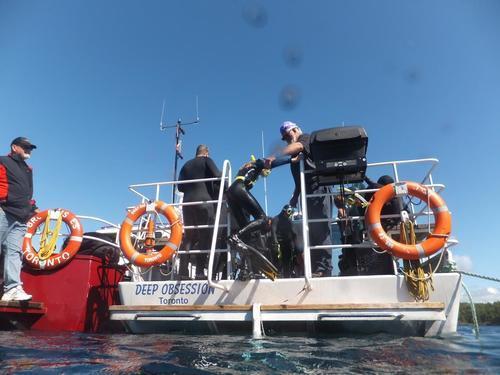David Gibbins's Blog, page 7
March 21, 2015
A Merchant Navy gun crew in action, February 1941: Captain Lawrance Wilfred Gibbins
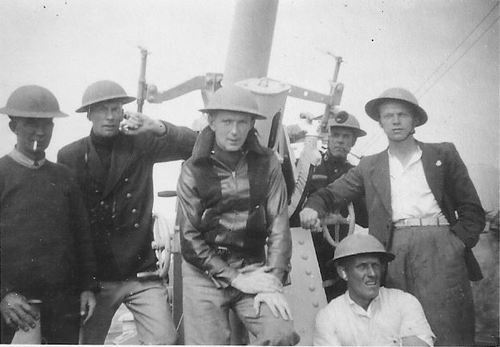
Gun crew aboard SS Clan Murdoch, c. 1940. Lawrance Wilfred Gibbins, Second Officer and Gunnery Officer, is second from the left (photographer unknown).
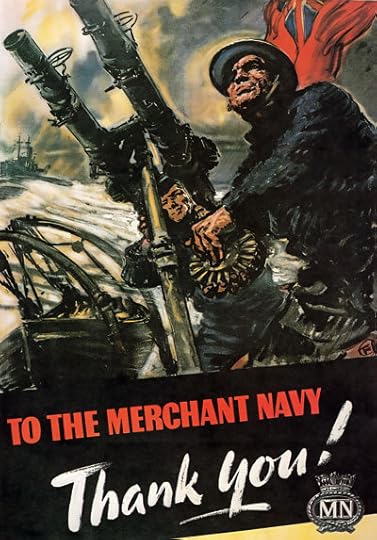
The photograph above, previously unpublished, is a rare image of a British Merchant Navy gun crew during the early part of the Second World War, taken on board S.S. Clan Murdoch. The man second from left with the binoculars is my grandfather, Lawrance Wilfred Gibbins, the ship’s Second Officer and Gunnery Officer. To his left behind the gun smoking a pipe is a non-commissioned officer of the Royal Marines or Royal Artillery, and the other men are all ship’s officers (the Indian Lascar ratings aboard Clan ships were not trained as gunners). The gun is a 12 pounder (3 inch) gun of the type that equipped many merchant ships in the early months of the war, on a high-angle mount for use against aircraft.
From mid-1938 many Merchant Navy officers had been sent on Royal Navy gunnery courses in anticipation of war, with the Second Officer on each large ship typically being appointed Gunnery Officer. The experience of the latter stages of the First World War had shown that guns on merchant ships with trained gunners could be used effectively against surfaced U-boats and raiders, and this provision was extended to anti-aircraft defence in the Second World War. Many Merchant Navy officers such as my grandfather had begun their careers as Royal Naval Reserve cadets on board the school ships HMS Conway and HMS Worcester, so had experience of rifle shooting as well as naval discipline that made them suitable for gunnery training.
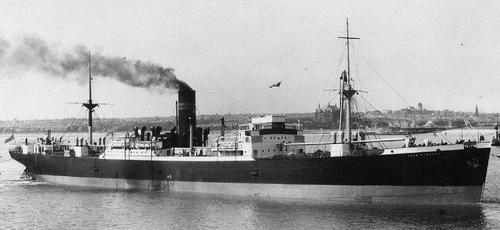
A superb image of Clan Murdoch before the war. The 12 pdr high-angle gun would have been mounted in the bow, so this image shows where the photo of the gun crew would have been taken. My grandfather was her Second Officer from 1937 until April 1941.
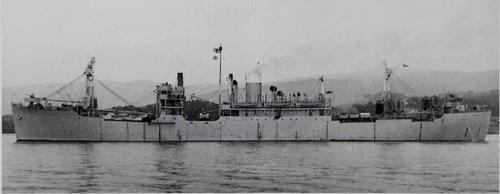
No pictures are known to me of Clan Murdoch during the war, but this photo of another of my grandfather's wartime ships, Clan Campbell - on which he was Second Officer for one voyage from India to England in late 1944 - gives an excellent impression of the wartime appearance of a British merchantman, including the grey paint scheme, the skid-mounted life rafts and the armaments. This Clan Campbell - the fifth Clan ship to bear the name - had been built to wartime specifications in 1943 with tubs for a 12 pdr high-angle gun forward, a 4-inch low-angle gun aft and 20mm Oerlikon or Bofors guns above the bridge and deck house. These would have replaced the Lewis guns and other rifle-calibre machine guns used earlier in the war, as seen in the propaganda poster above.
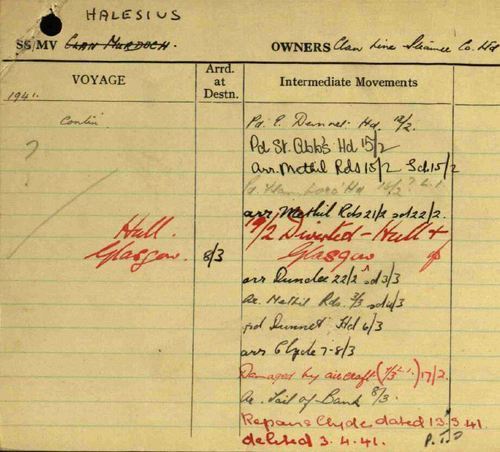
A page from the Ship Movement Card for Clan Murdoch (renamed Halesius after the war) in the UK National Archives, showing damage by aircraft on 17 February 1941 (the incident having been noted several days later in port, on 7 March).
By the end of 1940, the Defensively Equipped Merchant Ships (DEMS) organisation at the Admiralty had armed more than 3,400 merchant ships, and by the end of the war some 150,000 merchant seamen of many nationalities had attended Royal Navy gunnery courses and been issued proficiency certificates as ‘Merchant Seamen Gunners.’ In addition, the Admiralty provided DEMS gunners drawn from the armed services, including Royal Navy and Royal Marines reservists and in particular the Royal Artillery, with the Maritime Royal Artillery (created in early 1943) numbered at its peak over 14,000 men. These men served and fought alongside Merchant Navy gunners in all theatres of the war at sea, suffering the same high casualty rate as the other crew members when their ships were torpedoed or mined or attacked by aircraft and surface raiders.
The gun crew in this photograph were in action against German aircraft over the North Sea in February 1941, after Clan Murdoch had undertaken a five-month voyage to ports in Africa and India. She had returned with a cargo of iron from Freetown to the UK in convoy SL 62, which lost three ships in the space of 24 hours on 30-31 January to air attack off Ireland - the Belgian Olympier, the Norwegian Austvard, sunk with only 8 survivors, and the British SS Rowanbank, lost with her entire crew of 68 British officers and Lascar ratings. Two days later Clan Murdoch arrived on the Clyde, and a week after that she steamed in convoy around Scotland towards north-east England.
My grandfather described to me how the ship was bombed and strafed near the Humber Estuary, but that he and his crew were able to reach the gun in time and fire several rounds at the attacking aircraft. The Ship Movement Card for Clan Murdoch, reproduced here, shows that the action took place on 17 February when the ship was between Flamborough Head and Hull, and was ‘damaged by aircraft.’ During that weekend German air activity had been particularly intense off north-east England, with an estimated 90 aircraft laying mines off Flamborough Head and southwards on the 17th-18th, very probably including the aircraft that attacked Clan Murdoch. My grandfather kept two shell casings from this action and had them by his fireplace in later years. It was one of numerous occasions in which ‘non-combatant’ merchant seamen engaged enemy aircraft during the war, often resulting in attacks being averted and aircraft being damaged or destroyed.
Click here for an information sheet on the DEMS produced by the National Museums Liverpool, including reference to primary source materials, and here for a diary of incidents of air attack off north-east England in February 1941. The British officers of SS Rowenbank are commemorated on Panel 89 of the Tower Hill Memorial in London. I’d welcome contact from anyone who thinks they can identify the other men of Clan Murdoch in the photograph.
For one of my grandfather's other wartime ships, Empire Elaine, see my blogs here, and go here for my posting on the loss of Clan Macfadyen in 1942.
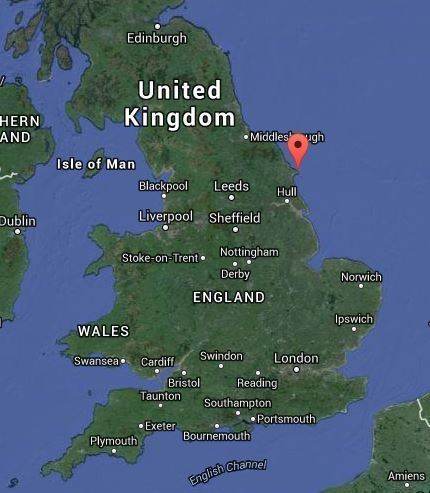
The air attack on Clan Murdoch on 17 February 1941 took place just south of Flamborough Head, shown by the red marker on this map.
A Merchant Navy gun crew in action, February 1941

Gun crew aboard SS Clan Murdoch, c. 1940. Lawrance Wilfred Gibbins, Second Officer and Gunnery Officer, is second from the left (photographer unknown).

The photograph above, previously unpublished, is a rare image of a British Merchant Navy gun crew during the early part of the Second World War, taken on board S.S. Clan Murdoch. The man second from left with the binoculars is my grandfather, Lawrance Wilfred Gibbins, the ship’s Second Officer and Gunnery Officer. To his left behind the gun smoking a pipe is a non-commissioned officer of the Royal Marines or Royal Artillery, and the other men are all ship’s officers (the Indian Lascar ratings aboard Clan ships were not trained as gunners). The gun is a 12 pounder (3 inch) gun of the type that equipped many merchant ships in the early months of the war, on a high-angle mount for use against aircraft.
From mid-1938 many Merchant Navy officers had been sent on Royal Navy gunnery courses in anticipation of war, with the Second Officer on each large ship typically being appointed Gunnery Officer. The experience of the latter stages of the First World War had shown that guns on merchant ships with trained gunners could be used effectively against surfaced U-boats and raiders, and this provision was extended to anti-aircraft defence in the Second World War. Many Merchant Navy officers such as my grandfather had begun their careers as Royal Naval Reserve cadets on board the school ships HMS Conway and HMS Worcester, so had experience of rifle shooting as well as naval discipline that made them suitable for gunnery training.

A superb image of Clan Murdoch before the war. The 12 pdr high-angle gun would have been mounted in the bow, so this image shows where the photo of the gun crew would have been taken. My grandfather was her Second Officer from 1937 until April 1941.

No pictures are known to me of Clan Murdoch during the war, but this photo of another of my grandfather's wartime ships, Clan Campbell - on which he was Second Officer for one voyage from India to England in late 1944 - gives an excellent impression of the wartime appearance of a British merchantman, including the grey paint scheme, the skid-mounted life rafts and the armaments. This Clan Campbell - the fifth Clan ship to bear the name - had been built to wartime specifications in 1943 with tubs for a 12 pdr high-angle gun forward, a 4-inch low-angle gun aft and 20mm Oerlikon or Bofors guns above the bridge and deck house. These would have replaced the Lewis guns and other rifle-calibre machine guns used earlier in the war, as seen in the propaganda poster above.

A page from the Ship Movement Card for Clan Murdoch (renamed Halesius after the war) in the UK National Archives, showing damage by aircraft on 17 February 1941 (the incident having been noted several days later in port, on 7 March).
By the end of 1940, the Defensively Equipped Merchant Ships (DEMS) organisation at the Admiralty had armed more than 3,400 merchant ships, and by the end of the war some 150,000 merchant seamen of many nationalities had attended Royal Navy gunnery courses and been issued proficiency certificates as ‘Merchant Seamen Gunners.’ In addition, the Admiralty provided DEMS gunners drawn from the armed services, including Royal Navy and Royal Marines reservists and in particular the Royal Artillery, with the Maritime Royal Artillery (created in early 1943) numbered at its peak over 14,000 men. These men served and fought alongside Merchant Navy gunners in all theatres of the war at sea, suffering the same high casualty rate as the other crew members when their ships were torpedoed or mined or attacked by aircraft and surface raiders.
The gun crew in this photograph were in action against German aircraft over the North Sea in February 1941, after Clan Murdoch had undertaken a five-month voyage to ports in Africa and India. She had returned with a cargo of iron from Freetown to the UK in convoy SL 62, which lost three ships in the space of 24 hours on 30-31 January to air attack off Ireland - the Belgian Olympier, the Norwegian Austvard, sunk with only 8 survivors, and the British SS Rowanbank, lost with her entire crew of 68 British officers and Lascar ratings. Two days later Clan Murdoch arrived on the Clyde, and a week after that she steamed in convoy around Scotland towards north-east England.
My grandfather described to me how the ship was bombed and strafed near the Humber Estuary, but that he and his crew were able to reach the gun in time and fire several rounds at the attacking aircraft. The Ship Movement Card for Clan Murdoch, reproduced here, shows that the action took place on 17 February when the ship was between Flamborough Head and Hull, and was ‘damaged by aircraft.’ During that weekend German air activity had been particularly intense off north-east England, with an estimated 90 aircraft laying mines off Flamborough Head and southwards on the 17th-18th, very probably including the aircraft that attacked Clan Murdoch. My grandfather kept two shell casings from this action and had them by his fireplace in later years. It was one of numerous occasions in which ‘non-combatant’ merchant seamen engaged enemy aircraft during the war, often resulting in attacks being averted and aircraft being damaged or destroyed.
Click here for an information sheet on the DEMS produced by the National Museums Liverpool, including reference to primary source materials, and here for a diary of incidents of air attack off north-east England in February 1941. The British officers of SS Rowenbank are commemorated on Panel 89 of the Tower Hill Memorial in London. I’d welcome contact from anyone who thinks they can identify the other men of Clan Murdoch in the photograph.
For one of my grandfather's other wartime ships, Empire Elaine, see my blogs here, and go here for my posting on the loss of Clan Macfadyen in 1942.

The air attack on Clan Murdoch on 17 February 1941 took place just south of Flamborough Head, shown by the red marker on this map.
March 11, 2015
PYRAMID: the sarcophagus of Menkaure and the wreck of the Beatrice
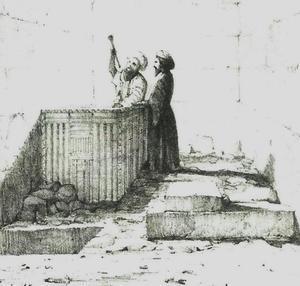
The sarcophagus inside the Pyramid of Menkaure, from Colonel Howard Vyse's Operations carried out at the Pyramids of Gizeh in 1837.
One of the greatest real-life mysteries to feature in my novel Pyramid is the whereabouts of the ancient Egyptian sarcophagus of Menkaure, lost in a shipwreck in the 19th century as it was being transported to England. In both Pyramid and my previous novel Pharaoh, Jack Howard and his team dive deep into the Mediterranean in the search for the wreck and its treasures.
You can read about the facts behind the fiction - what is really known of the sarcophagus and the wreck - by clicking on the image of the ship below, as well as a small excerpt from Jack's dive here.
March 9, 2015
Henry James Gibbins (1803-1877), perfumer and watercolourist
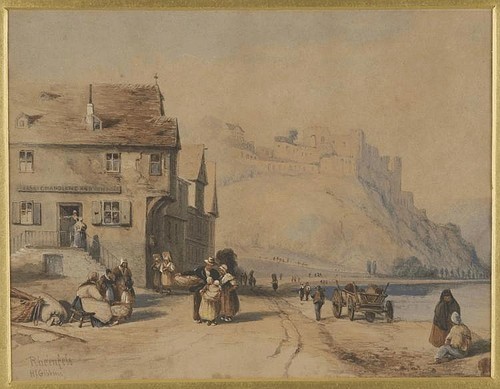
'Rheinfels' by H.J. Gibbins (watercolour, approx. 22 by 29 cm).
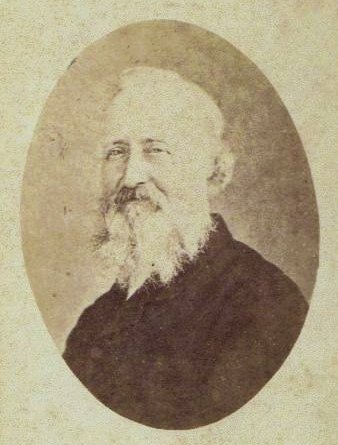
Photo of Henry James Gibbins taken at Dulwich, where he lived in retirement.
The painting above is by Henry James Gibbins, a prolific amateur watercolourist who exhibited at the Royal Academy in 1871. In his professional life Henry was a hairdresser, perfumer and purveyor of European fabrics and other finery, operating for many years from 7 King Street, St James, London, adjacent to the auction house Christie’s. Much of the property at the site was destroyed by German bombing in 1941, though Christie’s was rebuilt using the surviving façade and there is still a sense today of the appearance of the street during the early Victorian period when 'Gibbins’s Establishment' and his large family occupied the premises alongside.
The place of St James’s in the fine-arts trade was boosted after the French Revolution and then the fall of Napoleon, both of which brought greater exposure of French fashion to London. Henry – who followed his father Samuel into the profession –had himself gone to France to study his trade, at the 'Eleve de M. Nardin de Paris'. There he may have met his future wife, Louise Victoire Alphonsine Marchand, whose father was a perruquier (wigmaker) in Orleans and whose brother Isidore was to become a hairdresser to Queen Victoria.
Henry’s diverse business interests can be seen in the newspaper adverts in the gallery at the bottom of this page, showing that as well as being a hairdresser, perfumer and peruke (wig) maker, he marketed his own hair-restorer, ‘Gibbins’s Cream of Roses and Rosemary’, and took trips to the Continent to acquire materials for embroidery, tapestry-making and other ladies' occupations, as well as finished products. The trade card below extolling his French credentials (click to enlarge) is in the Fitzwilliam Museum, Cambridge. He made enough money to invest in the burgeoning insurance business, becoming a director of Prudential Assurance Company and leaving considerable shares in the company to his five daughters, as well as, to his wife, ‘ paintings, pictures, water-colour drawings and sketches, plate, china, linen, musical instruments, books and other articles of domestic use or ornament and wines, liquors and consumable stores …’
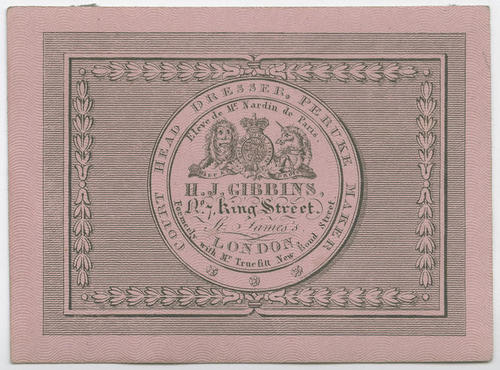
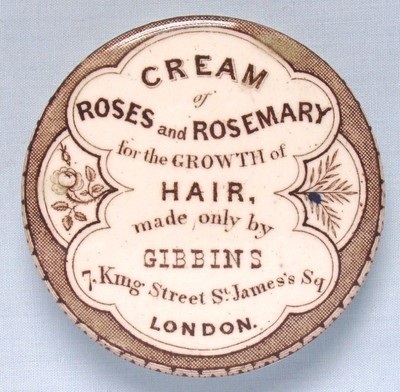
His dated watercolours known to me are of the 1860s and early 1870s, suggesting that this was a passion of his retirement after he had turned over the St James’s business to a son-in-law. His output was large - one descendant reports a family collection of some twenty paintings, and at least a similar number are known elsewhere from auction catalogues. They include rural landscapes and architectural studies in Britain and abroad, with scenes in Germany that may have been inspired by his travels there during his professional life. The two paintings known to have been exhibited by him were ‘Boulogne – low water’, at the Royal Academy in 1871, and ‘Herne Bay’ at the Royal Society of British Artists in 1872.
In addition to the picture at the top of this blog, the gallery below shows six of his watercolours for which I have decent images (click to enlarge). The upper three, all within one frame, are miniatures (the first only 11.5 by 9 cm) showing scenes on the Rhine, the last titled 'Fribourg' and signed. The lower three, all signed and titled, show Berne, dated 1860 (22.5 by 29.5 cm), a scene near Brienz, Switzerland, dated 1870 (26 by 46 cm), and Lewes.
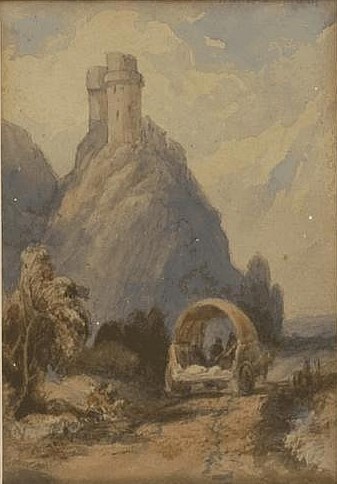
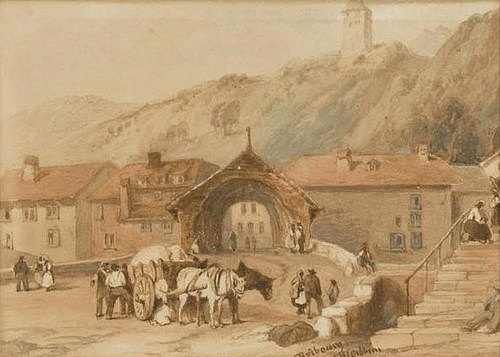
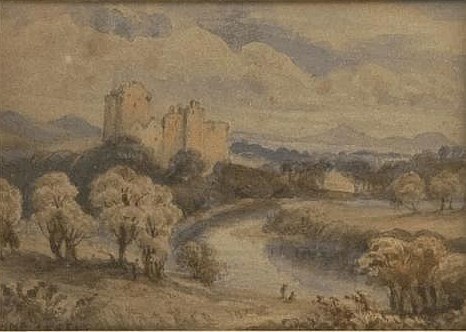
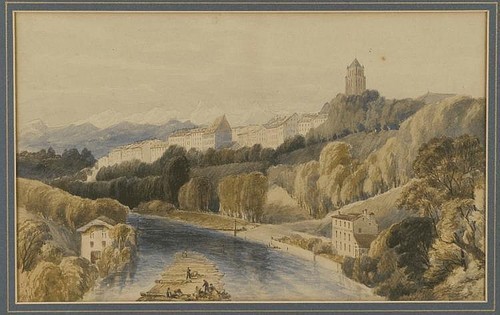
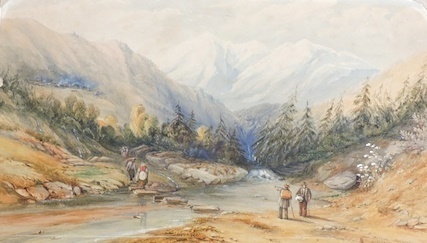
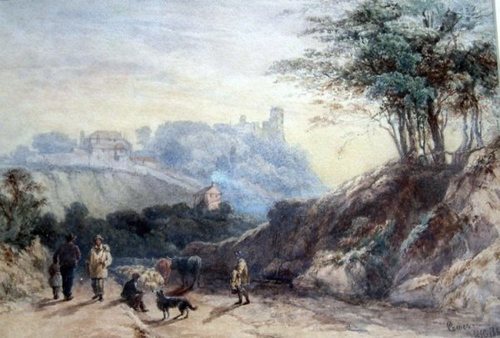
The gallery of newspaper excerpts below (click to enlarge), all from The Morning Post unless otherwise indicated, is a selection from many adverts for Gibbins' products in the London newspapers of the time, including The Morning Post, The Spectator, The Examiner, The Illustrated London News, London Charivari, The Indian News and The Court Journal. The earliest shown here, from 1825 for 'Bear's Grease', refers to the salon in Fleet Market of Henry's father, Samuel Gibbins. The rest are for Henry's own establishment in St James's, and chart his prosperity from soon after his return from Paris in the late 1820s to a time when 'Gibbins's Establishment' included 'salons de coiffure', premises for teaching hairdressing and his 'German and French Warehouse' for selling a wide range of products imported from the Continent, many of them not directly connected with hairdressing but clearly aimed at the well-to-do ladies who would frequent his establishment.
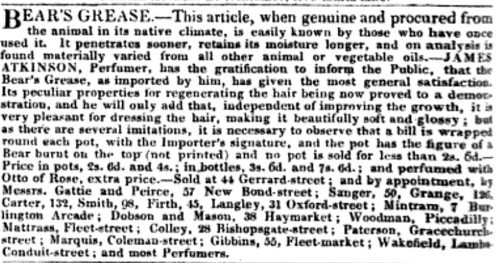
The Examiner 23 September 1825

29 April 1829
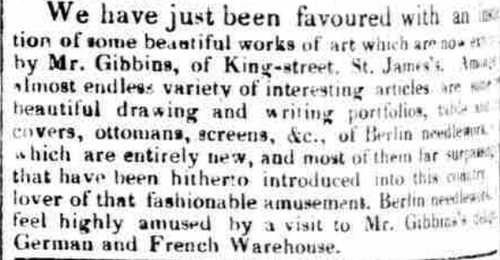
10 February 1836
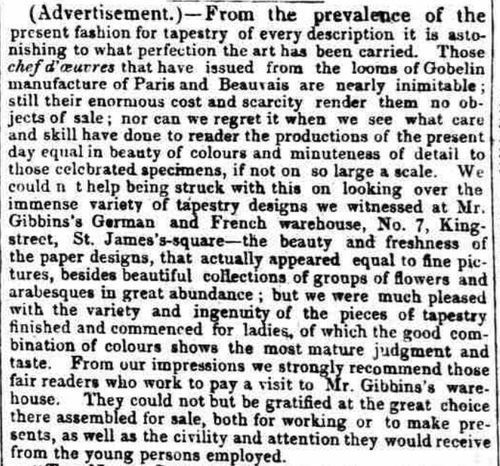
9 January 1841

16 November 1841
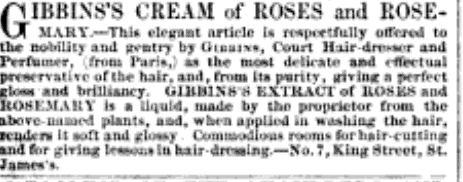
The Spectator 5 July 1845
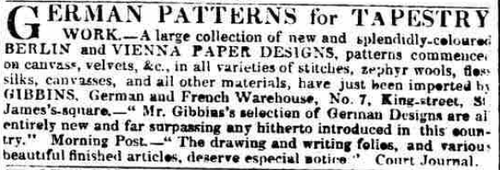
24 September 1849
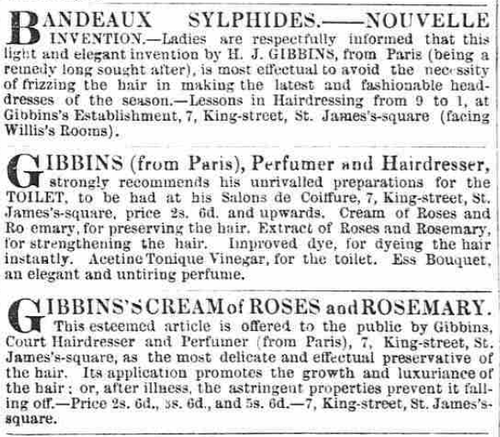
7 June 1854
For further details on Henry and his large number of descendants, including families in Australia, South Africa and Canada, go to Humphrey Stead's history here. More on Henry's daughter Adele Ulrige and her family can be found here, and on Henry's brother Edward Baines Gibbins and his family here. My branch of the Gibbins family is descended from Henry's other brother, Samuel Gibbins (1808-1886), a wool trader who became a Common Councillor of the City of London and Master of the Carpenters' Company.
March 5, 2015
PYRAMID: excerpt from the novel (the wreck of the Beatrice)
In my novel Pyramid, Jack and Costas revisit the wreck of the Beatrice - discovered in my previous novel, Pharaoh - in order to examine the ancient Egyptian sarcophagus of Menkaure for further clues to Akhenaten's lost 'City of Light'. To find out more about the real-life wreck and the sarcophagus, click here. After a horrifying accident with Costas' submersible, Jack has to make a snap decision:
And then it happened. The derrick screeched and the cable began to feed out again. Jack ripped off the headphones and glanced back to the derrick operator, seeing where the others had leapt forward to help him try to hold the brake, their tools cast aside. The cable was falling fast, dropping the submersible far beyond air-diving depth now. Jack turned, feeling as if he were in slow motion, his vision tunnelled, his metabolism slowed as if he were already in dive-response, his system anticipating what his brain was telling it and doing all it could to maximise his chances of survival. He blew on his nose to clear his ears, keeping his nose pinched, and with his other hand scooped up the weight-belt of one of the divers, holding it tight and bounding to the edge of the deck beside the cable. He was barely conscious of those around him, of Macalister’s shocked face, of the two divers too stunned to move, of voices behind yelling at him not to do it.
He stared into the abyss. All that he thought of was the darkness, and Costas.
He breathed fast, gulping in the air, took a final deep lungful, and jumped.
From Pyramid by David Gibbins (Headline, 2015)
Copyright 2015 David Gibbins
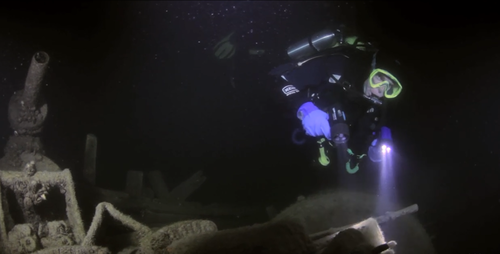
David Gibbins at night on the wreck of the Alice G, Tobermory, Canada. Click on the image to see the film of this dive (photo: Alan Gibbins).
Pyramid: excerpt from the novel (the wreck of the Beatrice)
In my novel Pyramid, Jack and Costas revisit the wreck of the Beatrice - discovered in my previous novel, Pharaoh - in order to examine the ancient Egyptian sarcophagus of Menkaure for further clues to Akhenaten's lost 'City of Light'. To find out more about the real-life wreck and the sarcophagus, click here. After a horrifying accident with Costas' submersible, Jack has to make a snap decision:
And then it happened. The derrick screeched and the cable began to feed out again. Jack ripped off the headphones and glanced back to the derrick operator, seeing where the others had leapt forward to help him try to hold the brake, their tools cast aside. The cable was falling fast, dropping the submersible far beyond air-diving depth now. Jack turned, feeling as if he were in slow motion, his vision tunnelled, his metabolism slowed as if he were already in dive-response, his system anticipating what his brain was telling it and doing all it could to maximise his chances of survival. He blew on his nose to clear his ears, keeping his nose pinched, and with his other hand scooped up the weight-belt of one of the divers, holding it tight and bounding to the edge of the deck beside the cable. He was barely conscious of those around him, of Macalister’s shocked face, of the two divers too stunned to move, of voices behind yelling at him not to do it.
He stared into the abyss. All that he thought of was the darkness, and Costas.
He breathed fast, gulping in the air, took a final deep lungful, and jumped.
From Pyramid by David Gibbins (Headline, 2015)
Copyright 2015 David Gibbins

David Gibbins at night on the wreck of the Alice G, Tobermory, Canada. Click on the image to see the film of this dive (photo: Alan Gibbins).
March 3, 2015
A 1770 Indenture of Matthias Gale, merchant, of London, Whitehaven and Maryland

This indenture of 28 June 1770, never previously published, contains an agreement between Matthias Gale of London, merchant, and John Hasill, mariner, regarding the ownership of a property in Workington, a town in Cumbria on the north-west coast of England near the port of Whitehaven. Matthias, whose elder brother John was my ancestor, was one of an extensive family in Whitehaven who had prospered in trade with the American colonies, where they owned tobacco interests in Maryland and Virginia and several of them settled (Matthias' uncle George Gale married the widowed Mildred Washington, grandmother of the future President George Washington).

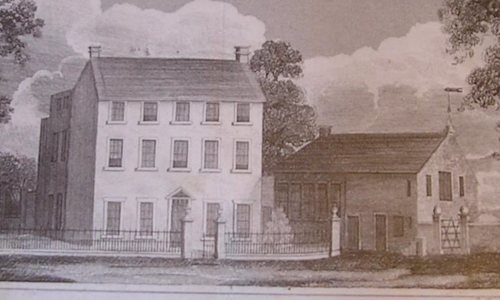
Catgill Hall, Cumbria, in the 1820s.
You can read all about the Gale family in the 18th century and their American connections on this excellent website by Gayle Mandell, and you can see Matthias' place in the family pedigree below from Burke's Family Records (1894). Like his brothers and uncles, Matthias was a merchant whose considerable interests included ship-owning, acting as an agent for American colonists, land ownership and speculation in Maryland and Virginia as well as in property in Britain, as shown by this indenture. Much of the Gale family fortune rested on their involvement in the tobacco trade. Though based in London, Matthias had been born in Whitehaven and from 1765 owned Catgill Hall, a country house that still exists near Egrement in Cumbria.
Matthias' daughter Jane married her second cousin Wilson Gale, who afterwards changed his name to Gale-Braddyll and became High Sheriff of Lancashire and Member of Parliament for Lancaster and Carlisle. The two paintings below by Joshua Reynolds, in the Wallace Collection in London and the Fizwilliam Museum in Cambridge, show Jane about 1788 and a family group about 1789. The boy is their son Thomas Richmond-Bradyll-Gale, who after serving as an officer in the 2nd Foot in the Peninsular War became an MP like his father.

Matthias' daughter Jane Gale-Braddyll, by Joshua Reynolds, 1788 (Wallace Collection, London, P47).

Jane Gale-Braddyll and family, by Joshua Reynolds, 1789 (Fitzwilliam Museum, Cambridge, PD.10-1955).

An extract from Burke's Family Records (1894) on the Gale family, showing Matthias. The same pedigree shows his descent from John Gale (born 1641), the first of the Whitehaven Gales, and also the descent from Matthias' brother John to my great-grandmother, Helen Mary Gale (born 1881). You can see the entire pedigree on Ancestry.co.uk.
March 2, 2015
PYRAMID: Sir Flinders Petrie and the discovery of the Israel Stele

The rendering of the Israel hieroglyphs that appears in my novel. The two kneeling figures signify a people or tribe, and the other symbols were read by Petrie's philologist Wilhelm Spiegelberg as I.si.ri.ar.
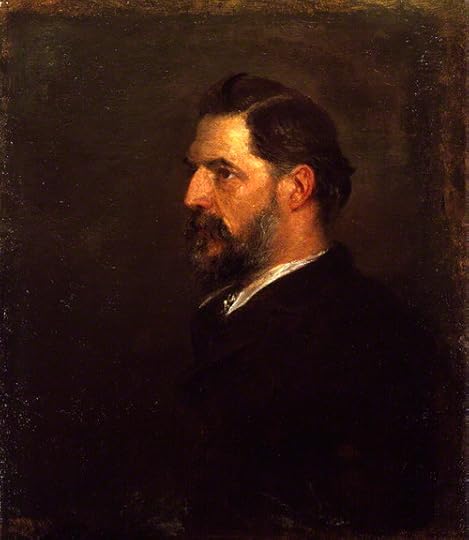
Flinders Petrie in 1900, soon after the discovery. Oil on canvas by George Frederick Watts. National Portrait Gallery, London, 3959.
My novel PYRAMID features the group of hieroglyphs shown above as an illustration dividing the Parts of the text. They’re not just decorative – they’re among the most famous hieroglyphs ever discovered in Egypt, a find that set the world alight at the very end of the Victorian era and gave scholars of the Old Testament something tangible to put alongside the Biblical narrative. In my novel, fictional Egyptologist Maurice Hiebermeyer discovers the hieroglyphs again in another context that makes their association with the Biblical Exodus indisputable, but the story of their real-life discovery almost 120 years ago is no less exciting and is one of the key moments of Egyptology, as significant for many as the discovery a generation later of Tutankhamun’s tomb.
In early 1896, the archaeologist Flinders Petrie – then only in his early 40s, but already acclaimed as one of the greatest Egyptologists – was directing excavations of a temple complex at Luxor, at the site of the ancient Egyptian capital of Thebes opposite the Valley of the Kings. Their discovery of the first known statue of Merenptah enabled Petrie to identify the building as the mortuary temple of the pharaoh, the late 13th century BC son and successor of Ramesses the Great. This in itself was of considerable interest, but neither the title of Petrie’s report, Six Temples at Thebes, nor his introductory chapter, give any hint of the excitement that was to follow. With typical archaeological understatement, all that he tells us by way of a preface was that most great discoveries are made by chance – requiring the archaeologist to excavate as completely as possible, not just to follow apparent clues – and that, in reflecting on the excavation, ‘though the results were less in some ways than I had hoped, yet in others they far exceeded what could have been expected.’
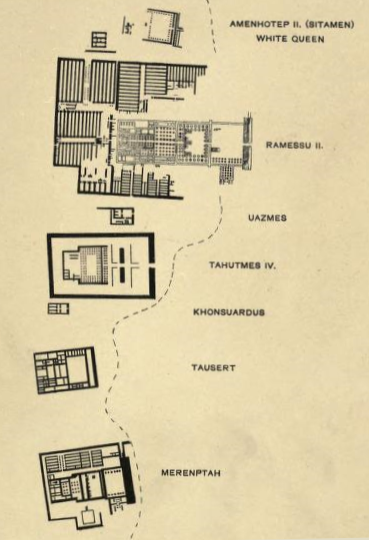
Petrie' original plan from his 1897 report Six Temples at Thebes showing the Temple of Merenptah at the bottom.
What they had discovered was an inscription that Petrie correctly predicted would be the most famous find of his career. The temple, constructed out of reused materials from the nearby temple of Amenhotep III, proved to have a pylon and colonnaded entrance fronting two courts, with chambers on either side. At the rear of the second court were parts of two colossal seated statues of Merenptah, one of them including the intact head - ‘The colour is still fresh upon it, yellow on the head-dress, red on the lips, white and black in the eyes.’
But the greatest find, in one corner of the forecourt, was a stele over ten feet high in the same black basalt as the statues, toppled forward from its original position against the wall. The rear face – the side facing upwards when it was excavated – contained an inscription of Amenhotep III, showing that it too had been reused from the temple of the pharaoh who had ruled some two centuries previously.
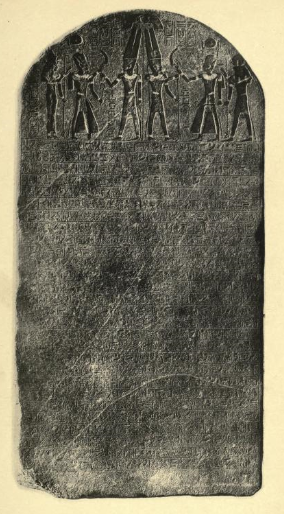
The photograph of the Merenptah Stele in Petrie's 1897 report, showing the difficulty of reading the hieroglyphs on the rough surface. Height: 3.2 m (currently in the Cairo Museum).
When Petrie was able to peer under it, he saw that the rough surface that had faced outwards on the courtyard wall - formerly the rear of the Amenhotep stele – had been carved with a detailed hieroglyphic inscription in which the name of Merenptah could be identified, below a coloured scene at the top showing Amen giving a sword to the pharaoh, backed by Mut and Khonsu. Petrie’s colleague and friend the German philologist Dr Wilhelm Spiegelberg was present that day, and was able to translate the largest part of the inscription as a celebration of Merenptah’s campaigns against the Libyans to the west. But when he reached the bottom lines he saw that they described a second campaign, against the ‘Sea Peoples’ to the north-east. His translation of that final part of the text is as follows:
‘(For) Ra has turned himself again to Egypt;
He is born to avenge it,
The King of Upper and Lower Egypt, Banera
Meriamen, sun of Ra Merenptah-Hetephermaat.
The princes bend down, saying ‘Hail!’
Not one raises his head among the Nine Bows.
Devastated is Tehenu,
Kheta is quieted,
Seized is the Kanaan with every evil,
Led away is Askelon,
Taken is Gezer,
Yenoam is brought to nought,
The people of Israel is laid waste – their crops are not,
Khor (Palestine) has become as a widow for Egypt
All lands together – they are in peace,
Every one who roamed about
is punished by King Merenptah, gifted with life,
Like the sun every day.
It was Petrie who had first suggested over dinner that evening that the word I.si.ri.ar should be translated as ‘Israel’. ‘Won’t the reverends be pleased,’ he is said to have remarked. The find hit the headlines around the world, and to this day the Merenptah stele remains the sole reference from Egypt of the 2nd millennium BC widely believed by scholars to refer to the Israelites of the Old Testament.
You can see Petrie’s full original report, Six Temples at Thebes. 1896. With a chapter by William Spiegelberg, Ph.D., of Strassburg University (London: Bernard Quaritch, 1897), including all of the illustrations, by clicking here. The Wikipedia entry on the Stele of Merenptah discusses details of the inscription and the debate that exists among some scholars over the translation and interpretation. Both the statue of Merenptah and the Stele can be seen today in the Cairo Museum.

The final lines of the Merenptah inscription, showing the I.si.ri.ar hieroglyphs in the middle line just right of centre. It's a mirror image because this is a depiction from the 1897 report of the 'squeeze' taken by Petrie shortly after the stele was uncovered.
February 18, 2015
THE SWORD OF ATTILA: read the Prologue
Click here for a free preview of the Prologue of my second Total War novel, and witness the birth of the man who would meet the army of Rome in the greatest battle the world had ever seen ...
Click here to find out more about the novel.
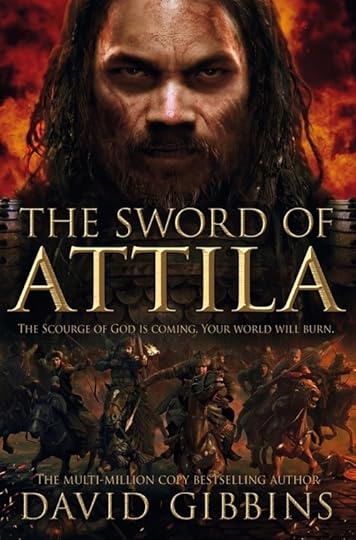
February 11, 2015
Diving on the wreck of the Charles P. Minch (1898), Tobermory, Canada
These pictures show my daughter in August 2014 on the wreck of the Charles P. Minch, a wooden schooner that went down in 1898 in Tecumseh Cove off Cove Island in Lake Huron, Ontario. Most of the wreckage lies in 7 to 15 m depth, and in common with the other wrecks here is exceptionally well-preserved in the cold fresh water. Many thanks to the crew from Diver's Den in Tobermory for making this such a great outing for us!
